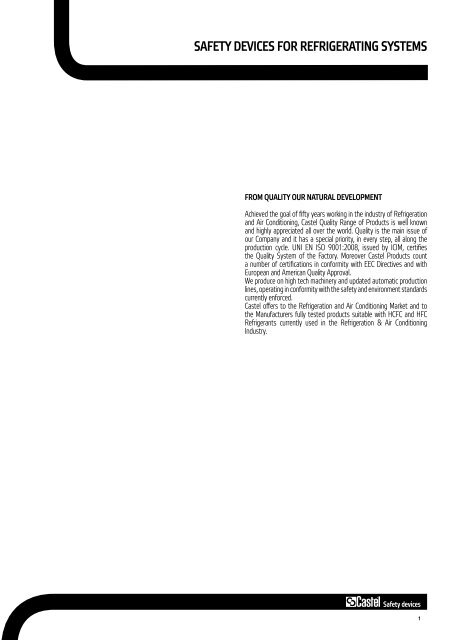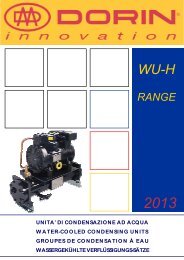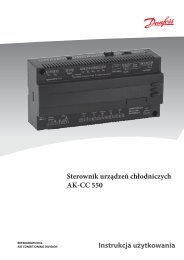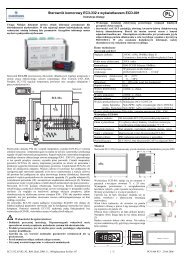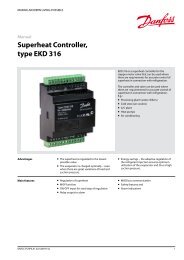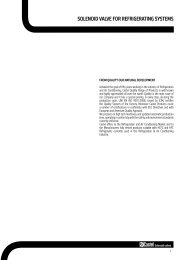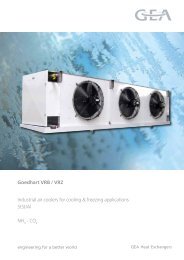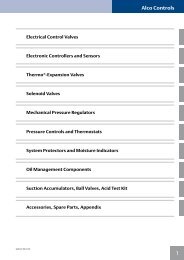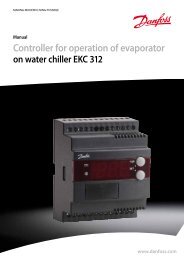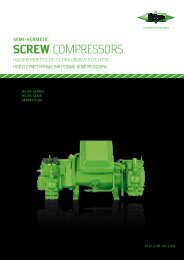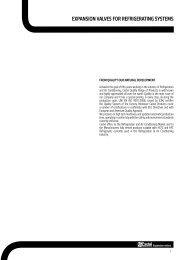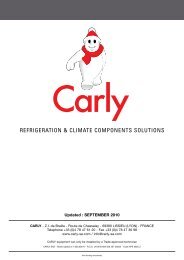SAFETY DEVICES FOR REFRIGERATING SYSTEMS - Berling
SAFETY DEVICES FOR REFRIGERATING SYSTEMS - Berling
SAFETY DEVICES FOR REFRIGERATING SYSTEMS - Berling
Create successful ePaper yourself
Turn your PDF publications into a flip-book with our unique Google optimized e-Paper software.
<strong>SAFETY</strong> <strong>DEVICES</strong> <strong>FOR</strong> <strong>REFRIGERATING</strong> <strong>SYSTEMS</strong>FROM QUALITY OUR NATURAL DEVELOPMENTAchieved the goal of fi fty years working in the industry of Refrigerationand Air Conditioning, Castel Quality Range of Products is well knownand highly appreciated all over the world. Quality is the main issue ofour Company and it has a special priority, in every step, all along theproduction cycle. UNI EN ISO 9001:2008, issued by ICIM, certifi esthe Quality System of the Factory. Moreover Castel Products counta number of certifi cations in conformity with EEC Directives and withEuropean and American Quality Approval.We produce on high tech machinery and updated automatic productionlines, operating in conformity with the safety and environment standardscurrently enforced.Castel offers to the Refrigeration and Air Conditioning Market and tothe Manufacturers fully tested products suitable with HCFC and HFCRefrigerants currently used in the Refrigeration & Air ConditioningIndustry.Safety devices1
July 2011Safety devices2
INDEX<strong>SAFETY</strong> VALVES 3030 PAG 05<strong>SAFETY</strong> VALVES 3060 PAG 10BALL SHUT-OFF VALVES <strong>FOR</strong> <strong>SAFETY</strong> VALVES PAG 13CHANGEOVER <strong>DEVICES</strong> <strong>FOR</strong> <strong>SAFETY</strong> VALVES PAG 15<strong>SAFETY</strong> VALVES UNIONS PAG 17BURSTING DISC <strong>SAFETY</strong> <strong>DEVICES</strong> 3070 PAG 18FUSIBLE PLUGS PAG 21EXTERNAL LEAKAGEAll the products illustrated in this Handbook are submitted, one byone, to tightness tests besides to functional tests. Allowable externalleakage, measurable during the test, agrees to the defi nition given inPar. 9.4 of EN 12284 : 2003 Standard:“During the test, no bubbles shall form over a period of at least oneminute when the specimen is immersed in water with low surfacetension, …”.PRESSURE CONTAINMENTAll the products illustrated in this Handbook, if submitted to hydrostatictest, guarantee a pressure strength at least equal to 1,43 x PS incompliance with the Directive 97/23/EC.All the products illustrated in this Handbook, if submitted to burst test,guarantee a pressure strength at least equal to 3 x PS according to EN378-2 : 2008 Standard.WEIGHTSThe weights of the items listed in this Handbook include packaging.GUARANTEEAll Castel products are covered by a 12 – months warranty. This warrantycovers all products or parts thereof that turn out to be defective withinthe warranty period. In this case, at his own expenses, the customershall return the defective item with a detailed description of the claimeddefects. The warranty doesn’t apply if the defect of Castel productsare due to mistakes either by customer or by third parties such wronginstallations, use contrary to Castel indications, tampering. In case ofdefects of its own products, Castel will only replace the defective goodsand will not refund damages of any kind.The technical data shown on this catalogue are indicative. Castelreserves the right to modify the same at any time without any previousnotice.The products listed in this handbook are protected according to the law.Safety devices3
<strong>SAFETY</strong> VALVES 3030For this reason, during relief, a gas leak occurs through this orifi ce.Utilized material: EN 12420-CW617N brass.Disc: obtained through bar machining and equipped with gasket, itensures the required sealing degree on the valve seat. The gasket ismade in P.T.F.E. (Polytetrafl uorethylene), a material that, during valveestimated service life, maintains a good strength and does not causethe disc to stick on the seat. The disc is properly guided in the body andthe guide action can never fail; there are no glands or retaining rings thathamper the movement thereof.Utilized material: EN 12164-CW614N brass.Spring: it opposes the pressure and the fl uid dynamic actions andalways ensures valve re-closing after pressure relief. The spring coils,when the disc has reached the lift corresponding to the state of relief atfull fl ow rate, are spaced apart by at least half the wire diameter and, inany case, by not less than 2 mm. The disc is equipped with a mechaniclock and when it attains it, the spring set does not exceed 85% of thetotal set.Utilized material: DIN 17223-1 steel for springs.Setting system: hexagonal head, threaded ring nut to be screwed insidethe body top by compressing the spring below. On setting completion,the position attained by the ring nut is maintained unchanged laying, inthe threaded coupling, a bonding agent with high mechanic strength andlow viscosity features to make penetration thereof easier. The settingsystem is protected against subsequent unauthorized interventions bymeans of a cap nut that is screwed outside the body and is sealed withlead to it.GENERAL DESCRIPTIONValves series 3030 are safety devices according to the defi nition givenin Article 1, Point 2.1.3, 2 nd dash of 97/23/EC Directive and are thesubject of Article 3, Point 1.4 of aforesaid Directive.The valves above mentioned are standard type, unbalanced, directloadedsafety valves. Valve opening is produced by the thrust the fl uidunder pressure exerts on the disc, when said thrust exceeds, undersetting conditions, the opposing force of the spring acting on the disc.Valves are identifi ed by means of:- a model number formed of an alphanumerical coding that includes:- in the fi rst part the family identifi cation (e.g. 3030/44C)- in the second part the setting pressure, expressed in bars, multipliedby 10 (e.g. 140)- an alphanumerical serial number.CONSTRUCTIONBody: squared, obtained through die forging and subsequent machining.It houses the following elements:- the nozzle with fl at sealing seat- the disc guide- the setting spring holder- the threaded seat of the setting adjusting ring nutIn the body, above the disc guide, a small pressure relief hole is providedthrough which the spring holder is put into contact with the atmosphere.TABLE 1: General Characteristics of valves 3030Catalogue Number 3030/44C 3030/66C 3030/88CConnectionsInlet connection wrenchtorque (min/max) [Nm]Inlet male 1/2” NPT 3/4” NPT 1” NPTOutlet male 3/4” G 3/4” G 1.1/4” G21/30 32/45 50/65Flow Diameter [mm] 12 12 19.5Flow Section [mm 2 ] 113 113 298Lift [mm] 4.1 4.1 6.8Discharge Coefficient "Kd" 0.90 0.90 0.83PS [bar] 55TS [°C] - 50 / + 150Set Pressure Range [bar] 8 / 50OverpressureBlowdownRisk Category accordingto PED5 % of set pressure15 % of set pressureIVSafety devices5
SCOPEUse: protection against possible overpressures of the apparatuseslisted below, with regard to the operating conditions for which theyhave been designed:- Refrigerating system and heat pump components, for instance:condensers, liquid receivers, evaporators, liquid accumulators, positivedisplacement compressor discharge, heat exchangers, oil separators,piping.(reference: EN 378-2:2008 Standard)- Simple pressure vessels(reference: 87/404/ EEC Directive)Fluids: the valves can be used with:- Refrigerant fl uids, in the physical state of gas or vapour, belonging toGroup 2 according to the defi nitions of 97/23/EC Directive, Article 9,Point 2.2 (with reference to 67/548/EEC Directive of June 27 th , 1967).- Air and nitrogen (reference: 87/404/EEC Directive)MARKINGIn conformity with the provisions of Article 15 of 97/23/EC Directive, theEC marking and the identifi cation number of the notifi ed body involvedin the production control phase are reported on the valve body.Still on the body, the following information is indicated:- Manufacturer’s mark, address and manufacture country- Valve model- Flow section- K d discharge coefficient- Indication of fl ow direction- Max allowable pressure- Allowable temperature range- Set pressure- Production date- Serial numberVALVE SELECTION97/23/EC Directive requires that pressure equipment, in whichpermissible limits are reasonably likely to be exceeded, shall be fi ttedwith suitable protection devices, for instance safety devices such assafety valves. Such devices shall prevent pressure from permanentlyexceeding the max allowable pressure PS of the equipment theyprotect. In any case, a short pressure peak limited to 10% of admissiblemaximum pressure is permitted.As to the selection and sizing of the suitable protection device, usersshall refer to the specifi c product and sector standards.EN ISO 4126-1: 2004 Standard: “Safety devices for protection againstexcessive pressure – Part 1: Safety valves”, harmonized with 97/23/ECDirective, specifi es general requirements for safety valves irrespectiveof the fl uid for which they are designed.EN 378-2 : 2008 Standard “Refrigerating systems and heat pumps –safety and environmental requirements – Part 2: Design, construction,testing, marking and documentation”, harmonized with 97/23/ECDirective, provides a general outline of the protection devices to beadopted in refrigerating systems and their features (par. 6.2.5). It alsoindicates the criteria for the selection of the device suitable to the typeand sizes of the system component to be protected (par. 6.2.6).EN 13136:2001/A1:2005 Standard “ Refrigerating systems and heatpumps – Pressure relief devices and their associated piping – Methodsfor calculation”, harmonized with 97/23/EC Directive, highlights thepossible causes of overpressure in a system and makes available tousers the instruments for pressure relief device sizing, among whichthe safety valves.SIZING OF <strong>SAFETY</strong> VALVES DESIGNED TO DISCHARGE GAS ORVAPOUR AT CRITICAL FLOW(REF. . EN ISO 4126-1: 2004 AND EN 13136 : 2001/A1:2005)Critical fl ow occurs when the backpressure pb (the pressure existingimmediately at the outlet of a safety valve) is below or equal to thecritical pressure:pb po2k 1 k k 1[bar ass]with:- p o = actual relieving pressure, upstream the safety valve; it’s equal tothe set pressure plus overpressure. That is a pressure increase over setpressure at which the disc has its total lift. [bar abs]- k = isentropic exponent of gas or vapour, based on the actual fl owingconditions at the safety valve inletIf k is unknown or anyway difficult to establish it’s possible to suppose:p 0,5 criticap o[bar ass]A safety valve, which discharges to atmosphere, works in critical fl ow.The safety valves designed to discharge gas or vapour at critical fl owmust be sized as follow:AcQmd 3,469 C 0,9 Kdvpoo[mm 2 ]with:- A c = minimum fl ow area of safety valve [mm 2 ]- Q md = minimum required discharge capacity, of refrigerant, of safetyvalve [kg/h]- K d = certifi ed coefficient of discharge- p o = actual relieving pressure, upstream the safety valve, see defi nitionabove. [bar abs]- v o = specifi c volume of gas or vapour at relieving conditions p o e To,meaning with To fl uid temperature at valve inlet, settled by the user orby the designer. [m 3 /kg]- C = function of isentropic coefficient k calculated from:k12 k1C 3,948 k k 1for this calculation the value of k shall be as measured at 25 °C. (Section7.2.3, EN 13136:2001/A1:2005 Standard).Values of k and calculated values of C for all the refrigerants are given intable A.1 of the aforesaid Standard. Following we show the values of kand C for the more useful refrigerants.Safety devices6
RefrigerantIsentropicCoefficientkFunction ofIsentropicCoefficientCR22 1,17 2,54R134a 1,12 2,50R404A 1,12 2,50R407C 1,14 2,51R410A 1,17 2,54R507 1,10 2,48Calculation of minimum required discharge capacity of safety valve isclosely linked to the type of system where the valve is installed, with thecauses that may arouse the opening of safety valve, i.e.:- External heat sources. The minimum required discharge capacity shallbe determined by the following:Qmd3600 Ahvapsurf[Kg/h]with:- = density of heat fl ow rate, it’s assumed to be 10 [kW/m 2 ]- A surf = external surface area of the vessel [m 2 ]- h vap = heat of vaporization of liquid at p o [kJ/kg]- Internal heat sources. The minimum required discharge capacity shallbe determined by the following:Qmd3600 Qhvaph[Kg/h]with Q h = rate of heat production [KW]- Excessive pressure caused by compressors. The minimum requireddischarge capacity shall be determined by the following:Qmd 60 V n 10 v[Kg/h]with:- V = theoretical displacement of compressor [m 3 ]- n = rotational frequency of compressor [min –1]- 10 = vapour density at refrigerant saturation pressure / dew point at10 °C [kg/m 3 ]- v = volumetric efficiency estimated at suction pressure and dischargepressure equivalent to the safety valve setting- Shell-and-tube horizontally liquid cooler fed with a thermostatic valve.- Refrigerant fl uid R407CCompressor data- Bore 82,5 mm- Stroke 69,8 mm- Cylinder number 6- Rotational frequency 1450 rpm- Clearance 4%The theoretical displacement of compressor is:V 0,082542 0,0698 6 0,00224[m 3 ]Maximum allowable pressure of the condenser, refrigerant side : PS =25 barSet pressure of the safety valve installed on the upper shell section ofcondenser : p set = 25 barActual relieving pressure of safety valve, choosing one valve type 3030with an overpressure of 5%: 5 p0 pset 1 1 27,25 100 [bar ass]Working conditions of compressor corresponding to the relieving ofsafety valve:Condensing temperature:+ 64 °C (27,25 bar abs)Evaporating temperature:+ 10 °C (6,33 bar abs)These conditions, settled in any case by the designer, are consideredthe most unfavorable for the safety valve in consequence of functionaldefects as:- Move mistake- Non-working of automatic safety devices, set to operate before safetyvalve.It shall be excluded.- Closeness the refrigerating system, the presence of fl ammablesubstances in so large quantities to be able to feed a fi re.- Inside the vessel, the presence of a heart source.Calculation of minimum discharge capacityPrudentially leaving the vapour overheating at the outlet of the liquidcooler out of account, the volumetric efficiency of compressor is:EXAMPLE OF CALCULATION OF MINIMUM REQUIREDDISCHARGE CAPACITY Q MD AND SIZING OF THE <strong>SAFETY</strong> VALVE<strong>FOR</strong> THE HIGH PRESSURE SIDE OF A <strong>REFRIGERATING</strong> SYSTEMvp 10,04pmandataaspirazione 127,250,046,33 0,83System descriptionCompact refrigerating system designed to make refrigerated water andconsisting of:- open type reciprocating compressor.- Water-cooled, shell-and-tube horizontally condenser with lower sectionof shell used as receiver.and so the minimum required discharge capacity:Qmd 60 V n 10 60 0,00224 1450 26,34 0,83 4260v[Kg/h]with 10 = 26,34 [kg/m 3 ], vapour density of R407C at saturationpressure / dew point at 10 °CSafety devices7
Vc D42 L[m 3 ]with:- D = rotor diameter [m]- L = rotor length [m]Ø DTABLE 2: Dimensions and Weights of valves 3030H2Catalogue NumberDimensions [mm]Weight[g]Ø D L Ch H 1H 2H 3H33030/44C 38 38 28 44 115 159 7803030/66C 38 38 28 44 115 159 7803030/88C 50 56 40 58 158 216 1960Sizing of minimum flow area of the safety valveAcChQmd 3,469 C 0,9 Kdvp4260 0,0104 3,469 1542,510,9 0,83 27,25oo[mm 2 ]with:- C = 2,51, corresponding to isentropic exponent k for R407C equal to1,14, according to table A1 of EN 13136:2001/A1:2005 Standard- K d = 0,83, certifi ed coefficient of discharge for safety valve 3030/88- v o = 0,0104 [m3/kg], specifi c volume of overheating vapour upstreamthe safety valve during relieving.This value is referred to the following operating conditions, upstreamthe safety valve:- pressure p o = 27,25 [bar ass]- temperature T o = 100 [°C] (precautionary temperature, settled in anycase by the designer)Conclusion: the selected safety valve is the model 3030/88 with thefollowing characteristics:- certifi ed coefficient of discharge, K d = 0,83- fl ow section, A c = 298 [mm 2 ]- set pressure, p set = 25 barLH1VALVE INSTALLATIONSafety valves type 3030 are guaranteed for reproducibility ofperformance, this means that after the valves have operated,open/close, the initial setting conditions are maintained.Nevertheless it is advisable to replace valve 3030 once it has dischargedbecause during release, piping debris, as metal shavings or solderimpurities, can place on the valve gasket and then, inhibits the safetyvalve from reseating at its originally conditions.As far as the installation of safety relief valves is concerned, thefundamental points listed below shall be taken into account:- Safety valves shall be installed near an area of the system wherevapours or gases are present and there is no fl uid turbulence; theposition shall be as upright as possible, with the inlet connector turneddownwards.- Vessels, joined together with piping rightly selected by the manufacturerand without any stop valve between them, may be considered as onlyone vessel for the installation of a safety valve.- The union between the valve and the equipment to be protected shallbe as short as possible. Furthermore, its passage section shall not benarrower than the valve inlet section. In any case, EN 13136:2001/A1:2005 Standard states that the pressure loss between protectedvessel and safety valve, at discharge capacity, shall not exceed 3% ofthe setting value, including any accessory mounted on the upstreamline.- In selecting the safety valve location, it shall be taken into accountthat valve operation involves the discharge of the refrigerant fl uid underpressure, sometimes even at high temperature. Where the risk existsto cause direct injuries to the persons nearby, an exhaust conveyingpiping shall be provided, which shall be sized in such a way as not tocompromise valve operation. EN 13136:2001/A1:2005 Standardstates that this piping shall not generate, at discharge capacity, aback pressure exceeding 10% of pressure p o , for standard type valves,unbalanced.To calculate the pressure loss either in the upstream line (betweenvessel and safety valve) or in the downstream line (between safetyvalve and atmosphere) refer to EN 13136:2001/A1:2005 Standard,Chapter 7.4.In case of single-screw compressor with injection of pressurized oil, thetheoretical displacement is:8Safety devices
Pressure loss in the upstream lineCalculation of pressure loss is given by:ppoin A 0,032 Acin C Kdr2 with:- A c = minimum calculated fl ow area [mm 2 ]- A in = inside area of inlet tube to valve [mm 2 ]- K dr = K d x 0,9, derated coefficient of discharge- C = function of isentropic coefficient k- = addition of pressure loss coefficients n of any component andpipingThe coefficients nare relevant to:- pipe elements loss, as connections and bends- valves loss- loss along the pipeand are listed in EN 13136:2001/A1:2005 Standard, Table A.4.Example: assume to install, on the condenser of the previous example,a safety valve type 3030/88, set to 25 bar, using a steel union with thefollowing characteristics:- d in = 28 [mm], inside diameter- A in = 616 [mm 2 ] inside area- L = 60 [mm], length- Flush connection to the shell of condenser, with a broken edgeFrom table A.4 it’s possible to have these data:- 1 (inlet) = 0,25- 2 (length) = x L/ d in = 0,02 x 60/28 = 0,043with = 0,02 for steel tube- T = 1 + 2 = 0,25 + 0,04 = 0,293Between safety valve and union it’s installed a shut-off valve type3033/88.The main characteristics of this valve are:- d R = 20 [mm], inside diameter- A R = 314 [mm 2 ], inside area- kv = 20 [m 3 /h], kv factorPressure loss coefficient R of shut-off valve is given by:R314 2,592 20 2 103 0,64The total pressure loss coefficient is : T + R = 0,933We remember the previous calculated fl ow area, the characteristics ofsafety valve 3030/88 and refrigerant fl uid R407C:- A c = 154 [mm 2 ]- Kdr = 0,83 x 0,9 =0,747- C = 2,51Pressure loss in the downstream lineCalculation of pressure loss is given by:p2 A c 21 0,064 C K dr po p2Aoutwith:- P 1 = inlet pressure to downstream line [bar ass]- P 2 = outlet pressure to downstream line, equal to atmospheric pressure[bar ass]- A c = minimum calculated fl ow area [mm 2 ]- A out = inside area of outlet tube to valve [mm 2 ]- K dr = K d x 0,9, derated coefficient of discharge- p o = actual relieving pressure, upstream the safety valve [bar abs]- C = function of isentropic coefficient k- = addition of pressure loss coefficients n of pipingThe coefficients n are relevant to:- pipe elements loss, bends- loss along the pipeand are listed in EN 13136:2001/A1:2005 Standard, Table A.4.Example: assume to install a discharge pipe on safety valve type3030/88 of the previous example, using a steel tube nominal size1.1/2”GAS with the following characteristics:- d out = 42,5 [mm], inside diameter- A out = 1418 [mm 2 ], inside area- L = 3000 [mm], length- pipe bend 90° with bending radius R equal to three times externaldiameter of tubeFrom table A.4 it’s possible to have these data:- 1 (bend) = 0,25- 2 (length) = x L/ d in = 0,02 x 3000/42,5 = 1,41with = 0,02 for steeltube- T = 1 + 2 = 0,25 + 1,41 = 1,66Pressure loss in the downstream line is: 154 2p1 0,064 1,66 2,510,747 27,25 1 2,125 1418ppouto2,125 1 0,04127,252[bar ass]The obtained value is admissible because lower than the value of 0,10forecast in EN 13136:2001/A1:2005 Standard.Pressure loss in the upstream line is:ppoin154 0,032 2,510,7476162 0,933 0,00656The obtained value is admissible because lower than the value of 0,03forecast in EN 13136:2001/A1:2005 Standard.Safety devices9
<strong>SAFETY</strong> VALVES 3060GENERAL DESCRIPTIONValves series 3060 are safety devices according to the definition given inArticle 1, Point 2.1.3, 2 nd dash of 97/23/EC Directive and are the subject ofArticle 3, Point 1.4 of aforesaid Directive.The valves above mentioned are standard type, unbalanced, direct-loadedsafety valves. Valve opening is produced by the thrust the fluid under pressureexerts on the disc, when said thrust exceeds, under setting conditions, theopposing force of the spring acting on the disc.Valves are identified by means of:- a model number formed of an alphanumerical coding that includes:- in the first part the family identification (e.g. 3060/45C)- in the second part the setting pressure, expressed in bars, multiplied by 10(e.g. 140)- an alphanumerical serial number.CONSTRUCTIONBody: squared, obtained through die forging and subsequent machining. Ithouses the following elements:- the nozzle with flat sealing seat- the disc guide- the setting spring holder- the threaded seat of the setting adjusting ring nutIn the body, above the disc guide, a small pressure relief duct is providedthrough which the spring holder is put into contact with the outputconnection.Utilized material: EN 12420-CW617N brass.Disc: obtained through bar machining and equipped with gasket, it ensuresthe required sealing degree on the valve seat. The gasket is made in P.T.F.E.(Polytetrafluorethylene), a material that, during valve estimated service life,maintains a good strength and does not cause the disc to stick on the seat.The disc is properly guided in the body and the guide action can never fail;there are no glands or retaining rings that hamper the movement thereof.Utilized material: EN 12164-CW614N brassSpring: it opposes the pressure and the fluid dynamic actions and alwaysensures valve re-closing after pressure relief.Utilized material: DIN 17223-1 steel for springs.Setting system: hexagonal head, threaded ring nut to be screwed insidethe body top by compressing the spring below. On setting completion,the position attained by the ring nut is maintained unchanged laying, in thethreaded coupling, a bonding agent with high mechanic strength and lowviscosity features to make penetration thereof easier. The setting system isprotected against subsequent unauthorized interventions by means of a capSafety devices10
nut that is housed into the brass body and is fixed in this seat with an edgecalking operation.SCOPEUse: protection against possible overpressures of the apparatuses listedbelow, with regard to the operating conditions for which they have beendesigned:- Refrigerating system and heat pump components, for instance: condensers,liquid receivers, evaporators, liquid accumulators, positive displacementcompressor discharge, heat exchangers, oil separators, piping.(reference: EN 378-2:2008 Standard)- Simple pressure vessels(reference: 87/404/ EEC Directive)Fluids: the valves can be used with:- Refrigerant fluids, in the physical state of gas or vapour, belonging to Group2 according to the definitions of 97/23/EC Directive, Article 9, Point 2.2(with reference to 67/548/EEC Directive of June 27 th , 1967).- Air and nitrogen(reference: 87/404/EEC Directive)MARKINGIn conformity with the provisions of Article 15 of 97/23/EC Directive thefollowing information are reported on the valve body.- Manufacturer’s mark, address and manufacture country- Indication of flow direction- Max allowable pressure- Set pressure- Allowable temperature range- Production date- Serial numberThe following data are stamped on the cap:- EC marking and the identification number of the notified body involved inthe production control phase- Valve model- Flow section- Kd discharge coefficientVALVE SELECTION97/23/EC Directive requires that pressure equipment, in which permissiblelimits are reasonably likely to be exceeded, shall be fitted with suitableprotection devices, for instance safety devices such as safety valves. Suchdevices shall prevent pressure from permanently exceeding the max allowablepressure PS of the equipment they protect. In any case, a short pressurepeak limited to 10% of admissible maximum pressure is permitted.As to the selection and sizing of the suitable protection device, users shallTABLE 3: General Characteristics of valves 3060Catalogue Number 3060/23C 3060/24C 3060/33C 3060/34C 3060/45C 3060/36C 3060/46CConnectionsInlet male 1/4” NPT 1/4” NPT 3/8” NPT 3/8” NPT 1/2” NPT 3/8” NPT 1/2” NPTOutlet male 3/8” SAE 1/2” SAE 3/8” SAE 1/2” SAE 5/8” SAE 3/4” G 3/4” GInlet connection wrench torque (min/max) [Nm] 10/15 10/15 14/20 14/20 21/30 14/20 21/30Flow Diameter [mm] 7.0 9.5 10.0Flow Section [mm 2 ] 38.5 70.9 78.5Discharge Coefficient "Kd" 0.63 0.69 0.63 0.69 0.45 0.92 0.93PS [bar] 55TS [°C] - 50 / + 150Set Pressure Range [bar] 9 / 50OverpressureRisk Category according to PED10 % of set pressureIVSafety devices11
efer to the specific product and sector standards.EN ISO 4126-1: 2004 Standard: “Safety devices for protection againstexcessive pressure – Part 1: Safety valves”, harmonized with 97/23/ECDirective, specifies general requirements for safety valves irrespective of thefluid for which they are designed.EN 378-2 : 2008 Standard “Refrigerating systems and heat pumps – safetyand environmental requirements – Part 2: Design, construction, testing,marking and documentation”, harmonized with 97/23/EC Directive, providesa general outline of the protection devices to be adopted in refrigeratingsystems and their features (par. 6.2.5). It also indicates the criteria forthe selection of the device suitable to the type and sizes of the systemcomponent to be protected (par. 6.2.6).EN 13136:2001/A1:2005 Standard “ Refrigerating systems and heatpumps – Pressure relief devices and their associated piping – Methodsfor calculation”, harmonized with 97/23/EC Directive, highlights thepossible causes of overpressure in a system and makes available to usersthe instruments for pressure relief device sizing, among which the safetyvalves.For sizing of safety valves series 3060 see the previous chapter of safetyvalves series 3030.VALVE INSTALLATIONSafety valves type 3060 are NOT guaranteed for reproducibility ofperformance, this means that after the valves have operated, open/close, the initial setting conditions are NOT maintained. Then it isnecessary to replace valve 3060 once it has discharged.For installation of safety valves series 3060 see the previous chapter ofsafety valves series 3030.Utilized material: EN 12164-CW614N brass.Ø DChH1 H2H3LTABLE 4: Dimensions and Weights of valves 3060Dimensions [mm]Catalogue NumberWeight [g]Ø D L Ch H1 H2 H33060/23C 21.5 35 20 33.5 46.5 80 1803060/24C 21.5 35 20 33.5 46.5 80 1953060/33C 21.5 35 20 33.5 46.5 80 1953060/34C 21.5 35 20 33.5 46.5 80 1953060/45C 24.5 39.0 23 37 52.5 89 2403060/36C 30 40 27 37 59.5 96.5 3603060/46C 30 40 27 40 59.5 99.5 380Safety devices12
BALL SHUT-OFF VALVES <strong>FOR</strong> <strong>SAFETY</strong> VALVESAPPLICATIONSWe would like to remember to our customer that the running ofpressure equipments and pressure assemblies is excluded by the scopeof Directive 97/23/EC but it‘s regulated in compliance with nationalregulations of Member States of European Communities.We think that these regulations, actually on updating with theCompetent Bodies of all the states to avoid confl icts with the ESR ofPED, could provide for periodical checks on the pressure equipmentsand assemblies.Any intervention for periodic checking or replacement of an installedsafety valve becomes very difficult if the protected vessel is notequipped with a shut-off valve.The shut-off valves series 3033 and 3063, installed between vesseland safety valve, allow removing the valve for periodic checking orreplacement without blowing off all the refrigerant from a section ofthe system. These valves can be used with the same fl uids foreseen forsafety valves series 3030 and 3060, in particularly:- Refrigerant fl uids, in the physical state of gas or vapour, belonging toGroup 2 according to the defi nitions of 97/23/EC Directive, Article 9,Point 2.2 (with reference to 67/548/EEC Directive of June 27 th , 1967).- Air and nitrogen(reference: 87/404/EEC Directive)CONSTRUCTIONCastel supplies to its customers the valves series 3033 and 3063in open position and the ball spindle is protected by means of a capscrewed to the body and sealed with lead to it. Any closing interventionon the valve forcedly causes the tampering of the seal and then theseinterventions shall be performed exclusively by:- staff authorized to work on the system- public servant of a Competent BodyThese persons will be responsible for the next valve reopening and thenew cap sealing with their own lead.The main parts of these valves are made with the following materials:- Hot forged brass EN 12420 – CW 617N for body- Hot forged brass EN 12420 – CW 617N, chromium plated, for ball- Steel, with proper surface protection, for the spindle.- P.T.F.E. for seat ball gaskets- Chloroprene rubber (CR) for outlet seal gaskets- Glass reinforced PBT for cap that covers the spindle.Safety devices13
SEALVALVE 3030/..H2AH2H3H1H3ABALL VALVE 3033/..SEALVALVE 3060/...H1Ø DALBALL VALVE 3063/...CSEALØ DALCTABLE 5: General Characteristics, Dimensions and Weights of valves 3033, 3063CatalogueNumber3063/223063/33Designed forvalve3060/23C3060/24C3060/33C3060/34CKv Factor[m3/h]2.5TS [°C]PS[bar]Dimensions [mm]min max Ø D A C L H1 H2 H35 1071/4"NPT3/8"NPTInlet connection wrenchtorque (min/max) [Nm]Weight [g]78 58 39.5 77.5 155 10/15 50078 58 39.5 77.5 155 14/20 5303060/45C3063/445 -50 +150 55 1078 58 44.5 84.5 162 21/30 5603060/46C1/2"NPT3033/44 3030/44C 10 13 101 73 59 100 245 21/30 710Risk Categoryaccording toPEDArt. 3.33033/88 3030/88C 20 20 1" NPT 107 77 72 123 323 50/65 107014Safety devices
CHANGEOVER <strong>DEVICES</strong> <strong>FOR</strong> <strong>SAFETY</strong> VALVESAPPLICATIONSThe changeover device type 3032 is a service valve for dual pressurerelief valves that allows using one valve while isolating the other fromthe system. This device allows the user to work on the isolated valve,for periodic checking or replacement, while the system is completelyoperative and the other valve is in service.N.B. : each safety valve placed on a changeover device must havesufficient capacity to protect the vessel alone.Valve type 3032/44 is supplied with:- Two female threaded connections 1/2” NPT with swivel nut, codeCastel 3039/4- two O-RingThese components ensure the perfect alignment of two safety valves3060/45.The valves series 3032 can be used with the same fl uids foreseen forsafety valves series 3030 and 3060, in particularly:- Refrigerant fl uids, in the physical state of gas or vapour, belonging toGroup 2 according to the defi nitions of 97/23/EC Directive, Article 9,Point 2.2 (with reference to 67/548/EEC Directive of June 27 th , 1967).- Air and nitrogen(reference: 87/404/EEC Directive)CONSTRUCTIONThe valve 3032 is designed so that it is never possible to close offboth ports at the same time, excluding all the two safety valves. Underworking conditions, the shutter must be clamped against one of thetwo seats of the valve, front port or back port, in order to ensurealways full discharge to the corresponding safety valve. Intermediatepositions of the shutter are not acceptable in order not to affect theoperation of both safety valves. The valve ensures a pressure dropperfectly compatible with the safety valve operation under conditionsof discharge of saturated vapour as well as overheated vapour.The main parts of these valves are made with the following materials:- Hot forged brass EN 12420 – CW 617N for body- Steel, with proper surface protection, for the spindle.- Chloroprene rubber (CR) and aramidic fi bers for gland seal- Chloroprene rubber (CR) for outlet seal gaskets- Glass reinforced PBT for cap that covers the spindle.Safety devices15
L3B3039/4GASKET3032/44H1BBCHIUSO-CLOSEDAABL33032/643032/663032/883032/108H2H1H2DAL1DAL1L2CatalogueNumberDesigned forvalveKvFactor[m3/h]TABLE 6: General Characteristics, Dimensions and Weights of valves 3032TS [°C]Dimensions [mm]min maxPS[bar]D A B H1 H2 L1 L2 L3Inlet connection wrenchtorque (min/max) [Nm]Weight [g]3032/333060/33C3060/34C2.513 3/8” NPT 3/8” NPT 117 45 33 91 50 14/20 7753032/443060/45C3060/46C3.3 13 1/2” NPT 1/2” NPT 117 45 33 91 50 21/30 7753032/64 3030/44C 9.0 17.5 3/4” NPT 1/2” NPT 95 52 48 133 80 32/45 1750-50 +150 553032/66 3030/66C 9.0 17.5 3/4” NPT 3/4” NPT 95 52 48 133 80 32/45 17501”1”3032/8814.5 22.0120 71 66 185 110 50/65 3200NPT NPT3030/88C1”3032/108 20.0 31.0 1. 1/4” NPT123 74 66 185 110 60/80 3200NPTRiskCategoryaccording toPEDArt. 3.316Safety devices
<strong>SAFETY</strong> VALVES UNIONS3060Unions series 3035 allow assembling safety valves series 3030 and3060 or shut-off valves series 3032, 3033 and 3063 close to thepressure equipments to protect, set up in a refrigerating system.These unions are designed for installations according to the followingtwo ways:- Make a copper tube jointing the pressure equipment to the union, fi tthe end of this tube into the solder connection of the union and thenmake a capillary brazing.- Drill the inner/outer pipe close to the pressure equipment (if possiblemake a collar on the pipe), put the end of the union into this drill andthen make a braze welding.The unions series 3035 are machined by brass bar EN 12164-CW614N3035Copper tubeTABLE 7: General Characteristics, Dimensions and Weights of unions 3035ConnectionsDimensionsChØ DLCatalogue NumberNPTODSØ [mm]PS [bar]D L ChWeight [g]3035/2 1/4” 1218 33 21 583035/3 3/8” 18 22 36.5 26 90.53035/4 1/2” 22 28 44 32 165553035/6 3/4” 28 35 51 40 2553035/8 1” 35 42 72 45 3643035/10 1.1/4” 42 54 67 55 613Safety devices17
BURSTING DISC <strong>SAFETY</strong> <strong>DEVICES</strong> 30701/2" NPTCh.27301/8" NPT85Ch.271/2" NPTGENERAL DESCRIPTIONBursting disc safety devices 3070 are safety devices according to thedefi nition given in Article 1, Point 2.1.3, 2 nd dash of 97/23/EC Directiveand are the subject of Article 3, Point 1.4 of aforesaid Directive.Safety device 3070 is a non-reclosing pressure relief device where thebursting disc is sensitive to the differential pressure and it is designedto burst at a specifi ed pressure.Safety device 3070 are identifi ed by means of:- a model number formed of an alphanumerical coding that includes:- in the fi rst part the family identifi cation (e.g. 3070/44C)- in the second part the setting pressure, expressed in bars, multipliedby 10 (e.g. 140)- a serial number for lot production.CONSTRUCTIONBursting disc holder: it is the body of the device, manufactured in twohalf parts screwed together, that holds the bursting disc in the properposition. The two half bodies are obtained through bar machining; thelower body houses the inlet connection, while the upper body housesthe outlet connection and two service pressure 1/8”NPT.Bursting disc: The bursting disc contained into the safety device 3070is a conventional domed type (forward acting) where the burstingpressure is applied to the concave side. The discs are designed andtested, according to the requirements of EN ISO 4126-2:2003Standard, to burst at an established pressure. This pressure is calledspecifi ed burst pressure, quoted with a coincident temperature andwith a performance tolerance. The disc is manufactured with a sheet ofmaterial of calibrated width, Nickel, contained in a copper ring case.SCOPEUse: protection against possible overpressures of the apparatuseslisted below, with regard to the operating conditions for which theyhave been designed:- Refrigerating system and heat pump components, for instance:condensers, liquid receivers, evaporators, liquid accumulators, positivedisplacement compressor discharge, heat exchangers, oil separators,piping.(reference: EN 378-2:2008 Standard)Fluids: the valves can be used with:- Refrigerant fl uids, in the physical state of gas or vapour, belonging toGroup 2 according to the defi nitions of 97/23/EC Directive, Article 9,Point 2.2 (with reference to 67/548/EEC Directive of June 27 th , 1967).Safety devices18
ConnectionsMARKINGTABLE 1: General Characteristics of rupture discs 3070Catalogue Number 3070/44Inlet maleOutlet femaleServiceInlet connection wrench torque (min/max)[Nm]Pb toleranceIn conformity with the provisions of Article 15 of 97/23/EC Directivethe following information are reported on the bursting disc holder.- Manufacturer’s mark- EC marking and the identifi cation number of the notifi ed body involvedin the production control phase- Valve model- Flow section- Indication of fl ow direction- Bursting pressure- Performance tolerances- Coincident temperature to bursting pressure- Production date- Lot numberBURSTING DISC <strong>DEVICES</strong> SELECTION1/2” NPT1/2” NPT2 x 1/8” NPT21/30Flow Diameter [mm] 12Flow Section [mm 2 ] 113PS [bar] 55TS [°C] - 50 / + 150Bursting Pressure Pb [bar]14162424,827,528from 14 up to bar +/- 15 %from 24 up to28 bar +/- 10%Coincident temperature Ta 22Correction factor of Pbfor Ta ≠ 22 °CMax operating pressureRisk Category according to PED-50 °C 1,13-35 °C 1,12-25 °C 1.10-10 °C 1,03-0 °C 1,0322°C 1.0040°C 0.9960 °C 0.9780 °C 0.95100 °C 0.94150 °C 0.9375 % Pb97/23/EC Directive requires that pressure equipment, in whichpermissible limits are reasonably likely to be exceeded, shall be fi ttedwith suitable protection devices, for instance safety devices such asbursting disc safety devices. Such devices shall prevent pressureIVfrom permanently exceeding the max allowable pressure PS of theequipment they protect. In any case, a short pressure peak limited to10% of admissible maximum pressure is permitted.The bursting disc safety device 3070 may be used either as sole pressurerelief device or in conjunction with a Castel safety valve (types 3030 e3060). The combination disc plus valve prevents the refrigerant leakagethrough the safety valve and the total loss of refrigerant after the discburst. This combination may be also equipped with a proper pressureswitch to detect if the valve has discharged.The bursting pressure of the safety device 3070 is affected by theoperating temperature of fl uid contained into the equipment to beprotected. The specifi ed bursting pressure Pb, stamped on the body, isthe nominal bursting pressure at the coincident temperature of 22 °C: Athigher operating temperatures the nominal bursting pressure is reducedwhile at lower operating temperatures the nominal bursting pressure isincreased. Refer to table 1 for temperature adjustment factors of Pb.As to the selection and sizing of the suitable protection device, usersshall refer to the specifi c product and sector standards.EN ISO 4126-2: 2003 Standard: “Safety devices for protection againstexcessive pressure – Part 2: Bursting disc safety devices”, specifi esgeneral requirements for design, manufacturing, inspection, testing,certifi cation, marking, packaging of bursting disc safety devicesEN ISO 4126-3: 2006 Standard: “Safety devices for protection againstexcessive pressure – Part 3: Safety valves and bursting disc safetydevices in combination”, harmonized with 97/23/EC Directive, specifi esgeneral requirements for design, application and marking for a productassembled from the in-series combination of safety valve and burstingdisc safety device.EN ISO 4126-6: 2003 Standard: “Safety devices for protection againstexcessive pressure – Part 6: Application, selection and installationof bursting disc safety devices”, gives guidance on the application,selection and installation of bursting disc safety devices used to protectpressure equipment from excessive pressureEN 378-2 : 2008 Standard “Refrigerating systems and heat pumps –safety and environmental requirements – Part 2: Design, construction,testing, marking and documentation”, harmonized with 97/23/ECDirective, provides a general outline of the protection devices to beadopted in refrigerating systems and their features (par. 6.2.5). It alsoindicates the criteria for the selection of the device suitable to the typeand sizes of the system component to be protected (par. 6.2.6).EN 13136:2001/A1:2005 Standard “ Refrigerating systems and heatpumps – Pressure relief devices and their associated piping – Methodsfor calculation”, harmonized with 97/23/EC Directive, highlights thepossible causes of overpressure in a system and makes available tousers the instruments for pressure relief device sizing, among whichthe safety valves.SIZING OF BURSTING DISC <strong>DEVICES</strong> DESIGNED TO DISCHARGEGAS OR VAPOUR AT CRITICAL FLOW (REF. . EN ISO 4126-6:2003)For the defi nition of critical fl ow see the chapter of safety valves series3030. A bursting disc safety device, which discharges to atmosphere,works in critical fl ow.The bursting disc device designed to discharge gas or vapour at criticalfl ow must be sized as follow:AcQmd 3,469 C vpoo[mm 2 ]with:- A c = minimum fl ow area of bursting disc [mm 2 ]- Q md = minimum required discharge capacity of bursting disc [kg/h]Safety devices19
- = bursting disc coefficient of discharge- p o = relieving pressure. [bar abs]- v o = specifi c volume of gas or vapour at relieving conditions p o e To,meaning with To fl uid temperature at valve inlet, settled by the user orby the designer. [m 3 /kg]- C = function of isentropic coefficient k. To calculate C and to fi nd thevalues of k and C for the more useful refrigerants, see the chapter ofsafety valves series 3030EN ISO 4126-6:2003 Standard establishes different values for thecoefficient of discharge “” depending on the nozzle entry confi gurationwhere the bursting disc is mounted. The following cases are shown inthe aforesaid Standard, Par. C.2.2.1:- In case of an internally protruding branch/nozzle: = 0,68- In case of a fl ush branch/nozzle whose inlet is not of hydrodynamicconfi guration: = 0,73- In case of a branch/nozzle with rounded or chamfered inlets(hydrodynamic confi guration): = 0,80Calculation of minimum required discharge capacity of bursting discsafety device is closely linked to the type of system where the valve isinstalled, with the causes that may arouse the opening of safety device,i.e.:- External heat sources- Internal heat sources- Excessive pressure caused by compressorsFor the calculation of minimum required discharge capacity in thesethree cases see the chapter of safety valves series 3030- Vessels, joined together with piping rightly selected by the manufacturer andwithout any stop valve between them, may be considered as only one vesselfor the installation of a safety device.- The union between the combination and the equipment to be protected shallbe as short as possible. Furthermore, its passage section shall not be narrowerthan the valve inlet section. In any case, EN 13136:2001/A1:2005 Standardstates that the pressure loss between protected vessel and combination, atdischarge capacity, shall not exceed 3% of the setting value, including anyaccessory mounted on the upstream line.- In selecting the safety device location, it shall be taken into account thatits operation involves the discharge of the refrigerant fluid under pressure,sometimes even at high temperature. Where the risk exists to cause directinjuries to the persons nearby, an exhaust conveying piping shall be provided,which shall be sized in such a way as not to compromise device operation. EN13136:2001/A1:2005 Standard states that this piping shall not generate,at discharge capacity, a back pressure exceeding 10% of pressure po, forstandard type valves, unbalanced.To calculate the pressure loss either in the upstream line (between vessel andsafety valve) or in the downstream line (between safety valve and atmosphere)refer to EN 13136:2001/A1:2005 Standard, Chapter 7.4.SIZING OF COMBINATED <strong>SAFETY</strong> <strong>DEVICES</strong> DESIGNED TODISCHARGE GAS OR VAPOUR AT CRITICAL FLOW (REF. . EN ISO4126-3: 2006)The combination is an installation which comprises a bursting disc safetydevice installed within five pipe diameters before the inlet of a safety valve.The combination of a specified safety valve with a bursting disc device ischaracterized by a combination discharge capacity factor “Fd”. According to ENISO 4126-3: 2006 Standard the coefficient “Fd”.is the ratio of the average ofcoefficients of discharge “Kd“ of combination, determined by the combinationtests, to the certified coefficient of discharge “Kd“ of the sole safety valve.As a alternative to testing to determine the “Kd“ factor of the combination, thesame standard permits the use of a default combination discharge capacityfactor of 0,9, value quite lower than the one obtained from testing. Then tosize a combination, safety valve /3030 or 3060) with bursting disc safetydevice (3070), follow the calculation indicated in the chapter of safety valve3030, but multiply for 0,9 the certified coefficient of discharge “Kd“.INSTALLATION OF BURSTING DISC <strong>DEVICES</strong> AND COMBINATIONSThe bursting disc safety devices must be replaced once they havedischarged. Device 3070 is a sealed component with not replaceablebursting disc; when the disc discharges it is necessary the replace allthe device.Max operating pressure of equipment to be protected shall be nomore than 75 % of burst pressure of safety device 3070, to avoiddisc damages o leakage. If operating pressure exceeds 85 % of burstpressure, safety device 3070 should be replaced immediately.As far as the installation of bursting disc safety devices and combinationdevices is concerned, the fundamental points listed below shall be taken intoaccount:- Safety devices shall be installed near an area of the system where vapoursor gases are present and there is no fluid turbulence.20Safety devices
FUSIBLE PLUGSGENERAL DESCRIPTIONFusible plugs series 3080/.C and 3082/.C are safety devices accordingto the defi nition given in Article 1, Point 2.1.3, 2 nd dash of 97/23/EC Directive and are the subject of Article 3, Point 1.4 of aforesaidDirective.According to the defi nition given in Point 3.6.4 of EN 378-1:2008Standard, fusible plug is a device containing material that melts at apredetermined temperature and thereby relieving the pressure.Castel has resolved to classify fusible plugs series 3080/.C and 3082/.Cin the Category of Risk I therefore fi xing their use, as protection devices,on specifi c pressure equipments, proper to the same Category of Risk I,in compliance with Annex II, Point 2, of 97/23/EC Directive.In consequence of this choice, fusible plugs series 3080/.C and 3082/.Ccannot be used, as sole protection devices, on pressure equipmentsproper to Categories of Risk higher than fi rst.CONSTRUCTIONThe body of the fusible plug is an NPT plug drilled with a taper hole. Apredetermined quantity of fusible alloy, with checked melting point, ispoured inside this hole.The parts of the fusible plugs are made with the following materials:- Brass EN 12164 – CW 614N, hot tinned, for the plug- Eutectic alloy with several components, cadmium free, for the fusiblematerialSCOPEUse: the fusible plugs are basically used to protect the components in arefrigerating system or heat pump against possible overpressures, withregard to the operating conditions for which they have been designed,in case of an excessive external heat source, such as fi re (point 6.2.6.6of EN 378-2:2008)Fluids: the fusible plugs can be used with refrigerant fl uids belongingto Group 2 according to the defi nitions of 97/23/EC Directive, Article 9,Point 2.2 (with reference to 67/548/EEC Directive of June 27 th , 1967).TABLE 8: General Characteristics, Dimensions and Weights of fusible plugs 3080 and 3082CatalogueNumberNPTConnectionsFlowDiameter[mm]FlowSection[mm 2 ]KdMeltingPoint[°C]Maximumworkingtemperature[°C]PS[bar](1)HexagonalKeyWrenchTorquemin/max[Nm]Weight [g]RiskCategoryaccordingto PED3080/1C 1/8” 4.9 18.812 7 / 10 113080/2C 1/4” 5.7 25.510 / 15 2379 68 42173080/3C 3/8” 8.5 56.7 14 / 20 393080/4C 1/2” 9.3 67.9 22 21 / 30 760.913082/1C 1/8” 4.9 18.812 7 / 10 113082/2C 1/4” 5.7 25.510 / 15 23138 127 30173082/3C 3/8” 8.5 56.7 14 / 20 393082/4C 1/2” 9.3 67.9 22 21 / 30 76I(1) : alla massima temperatura d’esercizioSafety devices21
MARKINGIn conformity with the provisions of Article 15 of 97/23/EC Directiveand of Point 7.3.3 of EN 378-2:2008 Standard the following data arereported on the hexagonal nut:- EC marking- Manufacturer’s logo- Max allowable pressure PS- Melting pointINSTALLATIONIf a fusible plug is mounted on a pressure vessel or any other partwhich it protect it shall be placed in a section where superheatedrefrigerant would not affect its correct function. Fusible plug shallnot be covered by thermal insulation. Discharge from fusible plugs shalltake place so that persons and property are not endangered by thereleased refrigerant. (point. 6.2.6.6 of EN 378-2:2008)EN 378-2:2008 Standard, harmonized with the 97/23/EC Directive,establishes that a fusible plug shall not be used as pressure reliefdevice on vessels containing refrigerants proper to A2, B1, B2, A3 e B3groups. The same Standard establishes that a fusible plug shall not beused as the sole pressure relief device between a refrigerant containingcomponent and the atmosphere for systems with a refrigerant chargelarger than 2,5 kg of group A1 refrigerant (ex. R22 ; R134a ; R404A ;R407C ; R410A ; R507).FUSIBLE PLUG SELECTION97/23/EC Directive requires that pressure equipment, in whichpermissible limits are reasonably likely to be exceeded, shall be fi ttedwith suitable protection devices, for instance safety devices such asfusible plugs. Such devices shall prevent pressure from permanentlyexceeding the max allowable pressure PS of the equipment theyprotect. In any case, a short pressure peak limited to 10% of admissiblemaximum pressure is permitted.with:- Ac = minimum fl ow area of fusible plug [mm 2 ]- Q md = minimum required discharge capacity, of refrigerant, of fusibleplug [kg/h]- K dr =derated coefficient of discharge of fusible plug, equal to 0,9 x Kd- p o = pressure upstream the fusible plug, inside the equipment to beprotected [bar abs]- v o = specifi c volume of gas or vapour at relieving conditions po e T o ,[m 3 /kg] (To is the fl uid temperature at plug inlet, settled by the user orby the designer)- C = function of isentropic coefficient k (as measured at 25 °C, seeSection 7.2.3, EN 13136:2001/A1:2005) calculated from:C 3,948 2k k 1k1k1Per l’individuazione dei valori di k e C per i più comuni fl uidi refrigeranti sirimanda al capitolo relativo alla valvole di sicurezza serie 3030.La valutazione della minima portata di scarico richiesta al tappofusibile è strettamente connessa alla causa primaria che può provocarel’intervento del tappo fusibile, cioè la sorgente di calore esterna. Laminima portata richiesta si determina con la formula:Qmd3600 Ahvapsurf[Kg/h]with:- = density of heat fl ow rate, it’s assumed to be 10 [kW/m 2 ]- Asurf = external surface area of the vessel [m 2 ]- h vap = heat of vaporization of liquid at po [kJ/kg]EN 13136:2001/A1:2005 also establishes that the following values forK dr shall be the maximum used depending on how the pipe between thevessel and the fusible plug is mounted on the vessel:- fl ush or fl ared connection: K dr = 0,70- inserted connection: K dr = 0,55As to the selection and sizing of the suitable protection device, usersshall refer to the specifi c sector or product standards.EN 378-2:2008 Standard “Refrigerating systems and heat pumps –safety and environmental requirements – Part 2: Design, construction,testing, marking and documentation” provides a general outline of theprotection devices to be adopted in refrigerating systems and theirfeatures (par. 6.2.5). It also indicates the criteria for the selection of thedevice suitable to the type and sizes of the system component to beprotected (par. 6.2.6).EN 13136:2001/A1:2005 Standard “ Refrigerating systems and heatpumps – Pressure relief devices and their associated piping – Methodsfor calculation”, harmonized with 97/23/EC Directive, highlights thepossible causes of overpressure in a system and makes available tousers the instruments for pressure relief device sizing, among whichthe fusible plugs.SIZING OF FUSIBLE PLUGS (REF. EN 13136:2001/A1:2005)As the fusible plugs discharge to atmosphere, they always work incritical fl ow (to know the defi nition of critical fl ow, see the chapter ofsafety valves series 3030).The fusible plugs must be sized as follow:AcQmd 3,469 C vpoo[mm 2 ]Safety devices22


